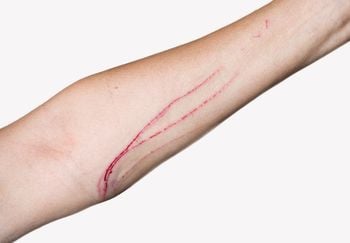Getting scratched by your cat can be not only a painful experience but can also impact your health.
Cat claws can cause significant trauma, potentially leading to wounds that bleed, swell, and become infected.
Immediate Care for a Cat Scratch
If the cat scratch has broken your skin, immediate action should be taken:
- Wash the wound(s) gently under running water — avoid scrubbing.
- Gently clean the wound with hand soap. Avoid cleaning with strong disinfectants or other chemicals, as they can sting and cause additional pain around the wound. Alternatively, clean the wound with a mild salt solution, made by mixing 1 teaspoon (5 ml) of table salt in 2 cups (500 ml) of water.
- Rinse for several minutes after cleaning.
- Control bleeding by applying pressure to the wound using an absorbent dressing or bandage.
- Apply antibiotic cream (e.g., Neosporin®) and cover with a sterile bandage.
- If your eye is scratched, seek immediate medical care.
- Do not let your cat lick your wound(s). It can cause Cat Scratch Fever, which I describe in more detail below.
Follow-Up Care for a Cat Scratch
 After the initial treatment of the cat scratch wound, watch out for the following signs:
After the initial treatment of the cat scratch wound, watch out for the following signs:
Around the site of the scratch and surrounding tissues
- Bleeding will not stop
- Increased pain
- Increased swelling
- Area of skin redness becomes wider
- Round, raised lesions
- Increase in the warmth of the skin
- Development of pus or other fluid
- Lymph nodes become swollen, tender, and/or painful
Other symptoms
- Fever
- Headache
- Poor appetite
- Exhaustion/fatigue
ALERT! If any of the above symptoms occur, contact your healthcare provider as soon as possible.
Scratching of hands and feet can be more prone to infection. Cosmetic damage in the form of scarring can also occur. The risk of infection is greater for people who have weakened or compromised immune systems.
How Serious is a Cat Scratch?
Although most cat scratches don’t cause problems, depending on the location and the depth of the scratch, as well as the health of the person who was scratched, they can lead to health issues. Only a medical doctor for humans can tell you for sure what is serious or not.
If you’ve been scratched by a cat and the wound does not heal or becomes worse, even after applying first aid at home, or you start feeling ill, you should contact your healthcare provider and have them examine the wound.
Cat Scratch Fever
One disease of notable concern is cat scratch disease (CSD), also called cat scratch fever. It is a bacterial infection caused by Bartonella henselae. It is spread by cats when they lick an open wound on a person or by bites and scratches that break the skin.
Typically, 3 to 14 days after the licking or infliction of the wound, it may appear swollen and red with round, raised lesions. Pus may be present, as well. Other signs of CSD are fever, headache, poor appetite, and exhaustion. As the disease progresses, lymph nodes near the original scratch or bite can become swollen, tender, or painful.
Serious complications from CSD are rare. However, it can affect your brain, eyes, heart, or other internal organs. Children 5 to 14 years of age and people with weakened immune systems are more at risk of developing these complications.
Most cats with CSD have no signs of illness. They can become infected with Bartonella henselae from flea bites and flea dirt (droppings) that get into their wounds when scratching or biting at fleas, and infected dirt gets in their nails or between their teeth or fighting with other cats that are infected.
For more information about this disease, visit the Center for Disease Control and Prevention (CDC).
Steps for the Prevention of Cat Scratch Disease
Since fleas are the carriers of the bacterium Bartonella henselae that causes cat scratch disease in cats, flea preventatives and control are helpful in the prevention of it. Learn more about what flea preventatives are available and most effective for cats.
Steps that you can take at home to keep flea populations down include:
- Using veterinarian-recommended flea and tick control for all your pets
- Vacuuming carpeting and upholstery on a weekly basis
- Washing human and pet bedding every seven days
Get more tips on The Best Way to Get Rid of Fleas in Your Home.
Why Do Cats Scratch?
Scratching is a normal behavior of cats. It is an instinct used to express emotions like excitement and anxiety, mark objects with the scent glands from their paws, and remove the outer layer of their nails.
Then there is scratching behavior that is directed at other living creatures. It can be done in play, like the inquisitive kitten who paws at your moving hand with unsheathed claws. Or as a defensive maneuver, akin to the cat who rolls on their back, seemingly to invite petting of their belly, only to swat away the offending hand with the quickness of an Olympic sprinter and, sometimes, razor-sharp claws.
Learn more about how to stop your cat from scratching your furniture and give them appropriate alternative scratching options in our article "Scratch This, Not That!"

What to Do if Your Cat Scratches During Play
If your cat scratches you during play, give your cat (and yourself) a time-out by simply removing yourself from the situation. Eventually, your cat will learn that playtime stops if they use their claws on your skin. Also, provide your cat with a variety of toys that can be used to touch, bite, and scratch. These toys can be used to redirect your cat's assertive play to something more appropriate.
In addition — and this is critical — do not use your hands as toys. As kittens, this can be seen as endearing, but as a cat grows, their claws and teeth can cause some serious damage. Reserve your hands for only things like petting, holding, and carrying.
What to Do if Your Cat Scratches Due to Aggression
Just like when scratching during play, if your cat scratches you as an aggressive act, remove yourself from the situation. But then you will need to do some investigative work to get to the root of the cause. First, talk to your veterinarian to rule out medical conditions, like pain, that may be the cause of the aggression.
If a medical issue cannot be identified, then your cat may have a behavioral problem that needs to be addressed. Reach out to a veterinarian in your area who has expertise in behavior or a certified behavioral consultant. Ask your family veterinarian for a recommendation or search the directory of the American Veterinary Society of Animal Behavior (AVSAB).
Minimizing Injury From Cat Scratches
Trim your cat’s nails on a regular basis to minimize injury. I recommend trimming them every 1–2 weeks. Not only does keeping those claws trimmed make the rogue attacks less painful for the recipient, but it also helps maintain the integrity of your furniture and other household items.
Until your cat becomes accustomed to having their nails handled and trimmed, as well as not scratching you in play, it may be worthwhile to equip yourself with some clothing armor to avoid injury, like long sleeves and pants.




